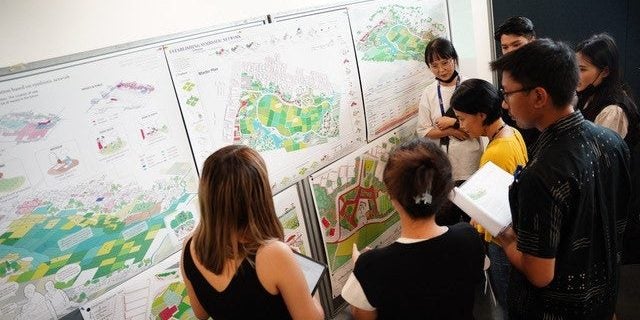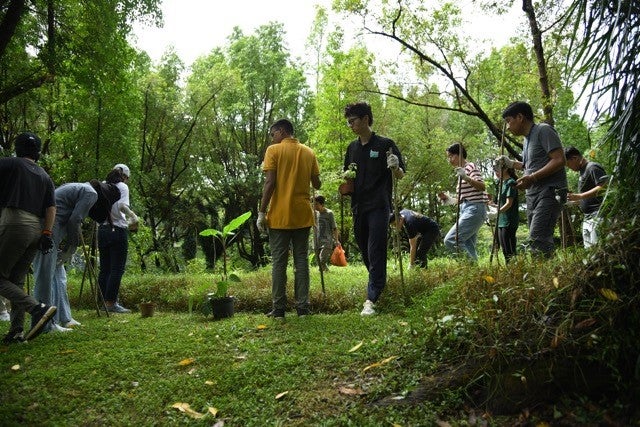Landscape Architecture in NUS: Bridging global trends with an Asian focus
20 Oct 2024

A design-focused approach to shaping the future of landscape architecture
The rapid growth of Asia-Pacific’s architectural services market is due to rapid urbanisation and increasing demands for smart homes. Solution providers in this sector need to have specific expertise in landscape architecture with an understanding of global trends. The Master of Landscape Architecture (MLA) at NUS utilises a global syllabus with a focus on the design of landscapes in Asia. Political and economic conditions are factored in to provide students with a comprehensive perspective of the field.
To learn more about the MLA programme, we spoke with Assistant Professor Dorothy Tang. Starting with a small plot twist, Dr Tang’s undergraduate major was originally horticulture where she intended to become a researcher in biotechnology. After realising her aversion towards working in a laboratory, she discovered her fascination with landscape architecture in a related Elective.
The idea of landscape architects working on different scales and across a diverse array of projects, from designing a garden to managing the landscape resources of a country, deeply intrigued her. She switched majors after her first semester as an undergraduate. After graduating, Dr Tang took her newfound expertise to New York City, where she worked on projects related to urban sustainability and resilience.
While at landscape architectural firm Michael Van Valkenburgh Associates, she was on the team that designed the award-winning Brooklyn Bridge Park, an exemplar in climate resilience. The park’s topography was designed to respond to a ‘100-year flood’, a term used to describe one of the most extreme storm events possible. When the destructive, category 3 Hurricane Sandy came and went, flooding many parts of the city, the park experienced minimal damage despite severe flooding in surrounding areas. Its topography also protected inland communities, making the recovery process much faster.
Today, she finds it exciting to teach MLA because Asia and its tropical setting is an exciting theatre for landscape architecture.

Focus on Asia
Dr Tang observes that in Southeast Asia, sustainability and working with ecological systems have been built into the DNA of the landscape architect profession. A pioneer in this regard, Singapore is an exemplary place. The expertise in this area has been translated into many different locations within the region. The economy is also starting to shift here, where government systems are planning builds with sustainability and resilience in mind. It is no longer an afterthought or a band-aid as was in the past.
She shared that as the only tertiary-level programme that qualifies graduates for accreditation as practising landscape architects in Singapore, the MLA is focused on practices in Asia. While global trends are relevant and covered in the syllabus, we are committed to producing knowledge to address the urgent issues of the region that we are in.
The courses we teach, most notably our design studio courses, are based in either Southeast Asia or other parts of Asia. In 2023, there was a studio investigating new types of “landmarks” in Korea, another developed landscape interventions in a typhoon-prone area of the Philippines, and in Singapore students explored the potential of small vacant sites as catalysts for social and ecological change. We believe that focusing on Asia allows our students a competitive edge, especially since Asia is one of the largest growth markets for landscape architecture now.
She adds that another interesting aspect of the programme is how design and research are equally integrated within the core curriculum and independent work. The research aspects build on our faculty’s strength and landscape research, especially in the region and get students to delve into new arenas of research that are motivated by design questions, instead of merely replicating design approaches by others indiscriminately.
When asked about staying current with trends, Dr Tang indicated that the MLA programme stays ahead of them by anticipating changes. The programme employs a pragmatic utopian approach to envisioning future challenges, especially in understanding how we can work with any client to advocate for a much more sustainable environment. When our students enter the profession, clients count on them for information and ideas on what is relevant in our new futures, and this motivates our students to explore alternative forms of practice and build a strong vision for their careers.
Our faculty is on the top of their game in terms of research and engaging with technologies. We have brilliant minds working on areas like vertical greening technologies, ecological systems within urban settings, and rewilding projects before their respective trends have been implemented en masse.
Additionally, the programme received a generous donation from Gardens by the Bay to organise a distinguished lecture series on landscapes and sustainability. This forum invites world-renowned landscape architects to discuss issues in the profession that go beyond simply designing a park or a roof garden, and expand into critical issues like urban design, climate change adaptation, and social and environmental equality issues. This lecture series complements ad-hoc conversations and lectures by practising landscape architects from Singapore and the region hosted by MLA. It also keeps the NUS community abreast of the most recent developments in landscape practice.

Singapore as a prototype and learning platform
Dr Tang shared that the programme leverages our location in Singapore to provide unique insights into landscape architecture. The programme possesses an inherently Asian and pantropical orientation while concurrently accentuating an urban perspective, making Singapore’s landscape architecture scene a highly relevant and enriching backdrop for students.
One example of Singapore’s focus on sustainable landscape architecture is Bishan-Ang Mo Kio Park. It is an adaptive landscape that allows for occasional flooding while coexisting with a public park. It utilises nature-based solutions such as bio-engineering technologies and bioretention basins to encourage the infiltration of rainwater and improve water quality. In addition to these sustainable functions, the park is one of Singapore’s most vibrant parks teaming with residents and visitors from afar in the evenings and weekends.
However, we are fully aware that landscape architectural solutions in Singapore are only possible due to the unique combination of governance structures, communities, and public resources that may not be available to other countries in Asia. This is why the programme uses Singapore as a laboratory and prototype for studying and then encourages students to adapt their interventions to better fit the specific cultures, economies, and governance styles in other parts of the world. To that end, our studios have taken lessons from Singapore to explore flooding and resilience in Manila and Jakarta, and transnational watershed management issues in Cambodia.

Supporting international students
Landscape architecture has students from different parts of the world. And the curriculum has been designed with this in mind, according to Dr Tang. During the first semester, the studio is organised to introduce students to the unique governance structures, ecologies, and communities of Singapore. This way, international students are immediately immersed in the unique context of Singapore and can continue in the programme productively.
Second, the programme encourages interaction between graduate students and undergraduates. This is facilitated through a programme started in 2020, where first-year graduate students and first-year undergraduates work together in a studio and all students in both programmes share a physical space. It creates a stronger sense of community and helps new students better assimilate into NUS. Singaporean students also gain a global perspective through their interaction with classmates from around the world.
Regarding teaching, the ratio for each studio is approximately one instructor to 12 students. This small class size allows new students to build close working relationships with their tutors and receive individualised attention and instruction customised to the student’s interests and progress.
Landscape architecture is helping to shape a more sustainable future for our planet. And just before that, the Master of Landscape Architecture programme is helping shape future landscape architects.
The NUS College of Design and Engineering graduate programmes relevant to the built environment are:
- Master of Landscape Architecture
- Master of Arts (Urban Design)
- Master of Arts in Architectural Conservation
- Master of Urban Planning
Read More
Department of Architecture ▏Master of Landscape Architecture ▏
Back to Scholar Insights to read more stories about CDE graduate programmes
College of Design and Engineering, NUS
Blk EA #06-16
9 Engineering Drive 1
Singapore 117575


